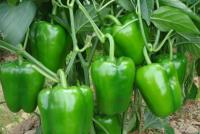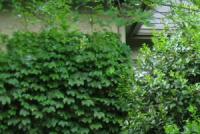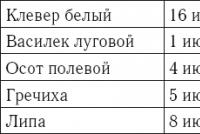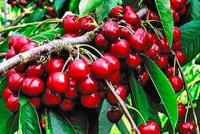Table flowering plants. Garden bloom calendar
Terms of flowering honey plants
In different years, the timing of flowering of honey plants may vary, since this depends largely on the weather and meteorological conditions in a particular area. The approximate calendar of flowering plants in central Russia is as follows (Table 1).
Table 1
Terms of flowering of honey plants in central Russia

Since the flowering of the main honey plants can begin much earlier or later than the indicated dates, because of this, the amount of collected honey is greatly reduced. Suppose a beekeeper assumes that the main bribes this season will begin at the same time as last year, for example, on June 30, therefore he will prepare bee families for this very period. Meanwhile, bribes do not start on June 30, but on July 18 due to the cold spring, that is, almost 3 weeks later.
Most of the force that was prepared for the beginning of a bribe will be confused, since in the summer months the average life expectancy of one bee does not exceed 35–40 days. This leads to a weakening of families, because of which the beekeeper will not be able to get the necessary amount of honey.
The yield of the apiary decreases even when the bees enter their optimum state with a delay — towards the end of the main bribe. If you compare the calendars of flowering honey plants in the same area, it becomes clear that the flowering period of the same plant is not the same, but the sequence of flowering is always the same. For example, the hazel-nut will always bloom earlier than willow-bredy, and this plant is earlier than the spicy maple.
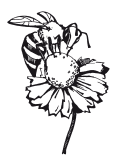
With the help of the calendar of flowering honey plants you can easily calculate when a particular plant will bloom, due to which they receive the main bribes in a particular area.
In order to correctly calculate the blooming period of any honey plants, you need to pay attention to plants from which the bees do not collect nectar or take it, but in smaller quantities: for example, a coltsfoot, birch, dandelion or lilac.
If the beekeeper is aware of when the main bribes come, he will be able to plan the work of his apiary: timely produce artificial swarming and grow brood, so that the family comes to the time of collecting the maximum amount of honey in its optimal strength.
In this regard, the beekeeper needs to annually draw up his own calendar of flowering of honey-bearing plants, since without him he will have to work at random and even in a good year to collect honey, you can be left without a harvest.
In drawing up the calendar takes into account all the features of the area, as the plants growing here, largely depend on the causes that affect flowering. For example, on the southern slopes of the hills, everything will bloom faster than on the northern ones. About the same features of the development of plants on the hills, hollows or beams. There should be no errors in the preparation of the calendar, since in 1.5–2 weeks the bees collect the main amount of honey.
If the beekeeper plans to make several migrations during the honey season, he will have to make several calendars at once, each of which will be tied to a specific area.
In drawing up the calendar, it is necessary to take into account the duration of flowering of each individual honey plant. If you make systematic annual observations of honey plants, you can calculate the average duration of flowering each. Due to this, choose the most opportune moment for migrating hives.
For the beginning of the calendar usually take the moment of flowering of the earliest melliferous, such as hazel. The flowering can be considered started when the corollas of the flowers of a small part of the plants unfold, while the rest actively fill buds or earrings at this time.
To collect a large amount of honey, the families themselves are actively preparing for the main bribe. The conditions of honey harvesting can be very different, as they completely depend on climate, soil, relief and other factors. In this regard, each beekeeper needs to carefully study the area where the hives are located.
From the book Grapes for beginners the author Larina Svetlana the author From the book Flower Care at your site. Flower calendar the author Kizima Galina Aleksandrovna 
Kizima Galina Aleksandrovna
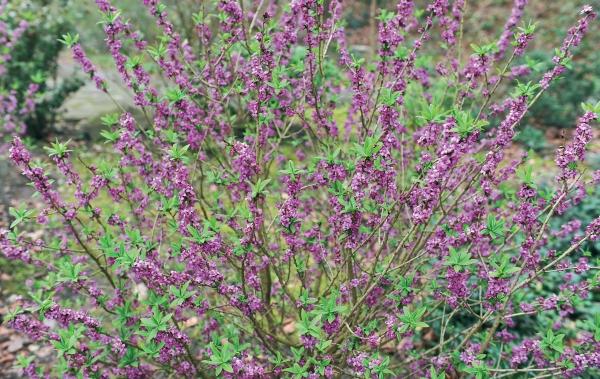
Typical battery lifetimes for various types of batteries and rechargeable batteries (subject to full charge) Nickel metal hydride (Ni-MH) batteries - 2 weeks (30% self-discharge per month). Nickel-cadmium (Ni-Cd) batteries - 3 weeks (self-discharge 20% per month). Lithium ion
45. Perennials. Planting dates in parks, depending on the timing of laying flowers and inflorescences.
For perennials include floral and ornamental plants, which for several years grow in one place and retain their decorative effect. The life cycle of these plants consists of alternating periods of development and rest.
Perennials are divided into the following groups according to the timing of the budding of flower buds:
The rudimentary organs of the flower are formed in summer, flowering occurs in the spring of next year (tulip, narcissus, hyacinth), the best time for planting such plants is autumn;
The rudimentary organs of the flower are formed in autumn, bloom is observed in the spring of the following year (primrose, iris, peony), the best time for planting these plants is immediately after flowering or in August;
The rudimentary organs of the flower are laid in the spring of the current year, flowering is observed in the summer or autumn of the same year (aquilegia, Achilles, delphinium), the best time for planting is August-early September;
The rudimentary organs of the flower are laid in the summer of the current year, flowering occurs in the fall (astilba, gelenium, phlox paniculata), the best time for planting is spring.
46. Nurseries of ornamental woody plants. Structure.
Nurseries of decorative tree species are the main source of planting material for gardening cities and populated areas, industrial areas, sports, school and medical institutions and individual plots, territories where reconstruction and restoration of plantings are carried out.
Decorative tree species nurseries are a kind of “house-building plants” that produce high-quality material on the stream. But if building structures can be made quickly, in a matter of hours or days, it takes from 3 to 25 years or more to grow a unit of production in a nursery.
Nursery structure.The nature of the grown material - the final sizes of the plants produced, the range - depends on the technological schemes of growing plants of different groups: trees, shrubs, grafted forms, etc., which in turn affect the structure of the nursery and the organization of its territory. When managing the entire cycle - from breeding to the release of planting material of a different nature - in the structure of the nursery there should be reproduction and formation departments. These departments are the main, determining all production activities and the system of organization of the territory of the nursery. To serve them, there should also be a brood farm, household buildings for different purposes, roads connecting different departments and parts of the territory in the nursery. In addition to the main divisions - reproduction and formation - on the territory of nurseries, depending on market demand, there can be organized departments for the production of fruit, flower crops, and also lawn grasses.
AT breeding departmentproduce seed sowing and rooting cuttings. There may also be a picking site in open ground. The breeding plantation also belongs to the breeding department. Plants are grown for 1–3 years, which depends on the biological characteristics of the plant and on the mode of reproduction. From the breeding department, the plants are transplanted into the formation department.
Main task in formation department -obtaining plants with certain sizes and forms of crown, trunk and root system in accordance with GOST 24909-81, 25769-83, 26869-86. In this section, the plants are periodically transplanted, increasing the feeding area each time. The process of transplanting is called cross-cutting, and the areas to which trees and shrubs are transplanted - schools.The formation department receives plants from the breeding department at the age of 1–3 years.
There are usually three schools in the formation department (I, I, III), but sometimes there is a fourth (IV).
Depending on the growth characteristics of the breeds and the agrotechnology of cultivation associated with this, schools are divided into: schools of fast, moderate and slow-growing deciduous trees; schools of fast and slow-growing conifers; schools of fast and slow-growing deciduous ornamental shrubs; schools of flowering slow and fast-growing shrubs; schools of grafted roses; grafted lilacs; grafted forms of other species; school of coniferous shrubs; School of architectural forms (shorn) bushes. Other schools may be allocated. The main indicator for assigning plants to a particular school is the duration of their cultivation and the relatively same cultivation technology.
In school I, seedlings are planted from seed beds and rooted green cuttings from the picking site. It has a branch of trees, where fast-growing breeds are grown for 5–6 years to seven years of age, and slow-growing breeds are 4–5 years old; in fast-growing rocks, a stem and crown are formed here, and in slow-growing rocks, only a stem; during this time, fast-growing breeds reach sizes at which plants can be used on landscaping sites, and nurseries implement them. Slow-growing breeds from this school are transplanted to school II; in the department of shrubs they are grown 2 - 3 years to five years of age; during this time, they form the aboveground part. In the first school of shrubs, fast-growing breeds also reach standard sizes and are realized. Slow-growing shrubs and species intended for obtaining large-sized (for example, for restoration) or architecturally shaped plants are transplanted to School II of shrubs; branch of graft forms, where seedlings of rootstocks are planted and their budding is carried out, as well as plants planted in winter in greenhouses and stored until vegetation in special storage facilities; grafted seedlings are also formed here.
The second school, except for trees and shrubs from School I, receives rooted cuttings of fast-growing trees and rooted cuttings from branch plantations. It carries out further formation of the trunk and crown.
In school II it usually happens: a branch of trees, where slow-growing trees are grown 4-5 years old to 9-14 years of age. They continue and complete the formation of the shtamb, form the first tier of the crown. From this school, slow-growing trees are sold, or transferred to school III, for the cultivation of large-scale material, walkway trees; Department of shrubs, where they are grown for 3 - 4 years to 7-8 years of age and from where produce large-scale material for the reconstruction of greenery. In shrubs form the aboveground part, and from plastic rocks can be obtained shrubs with a specific crown profile.
Fast growing trees from School I, slow-growing trees and shrubs from School II are transplanted to school III, or the school of long-term cultivation, to produce special architectural forms (crown in the shape of a ball, cone), grafted standard and semi-tumbling plants.
In the third school they grow up material for landscaping streets, squares, boulevards, avenues, for single landings, repair and restoration works, for use in greening neighborhoods. It also grows trees with artificial crown shape. There are such departments in it: 1) large-sized trees, where trees are grown for 6-10 years, they form well-developed crowns and keep shtabs clean. During the same period, trees taken from the forest can grow here; 2) architectural forms of trees and shrubs, where grafted and unvaccinated decorative forms are grown, create architectural forms of crowns. All plants in this compartment are designed for solitary and alearn plantings.
Schools establish various areas of nutrition for plants. In the breeding department: the sowing department is 0.01 m 2, the branch of green cutting is 0.003 m 2, the branch of woody cuttings is 0.028 m 2; in school I: 0.25 m 2 for bushes, 0.5 m 2 for trees; in school II: for bushes - 0.5 m 2, for trees - 1 m 2. In School III, depending on the size of the crowns, the food area can be from 2.25 m 2 (landing scheme 1.5 x 1.5) to 9 m 2 (landing scheme 3x3).
The listed departments and areas of nutrition are provided for the so-called "clean" schools, where shrubs and trees are grown separately. In modern conditions, the desire to maximize the mechanization of all the processes of growing planting material led to the creation of so-called mixed schools, where rows of trees alternate with rows of shrubs-compactors. Schemes of mixed schools were developed in the Ivanteevsky nursery of the Moscow region. During the operation, some shortcomings of mixed schools emerged, and now nurserymen are looking for opportunities for maximum mechanization in “clean” schools.
Uterine Farmingnecessary in the nursery as a source of seeds and cuttings and may have a different structure. With a sufficient area of the nursery, the uterine farm can be organized on its territory in the form of an arboretum and uterine plantations, as well as other plantations of the nursery. Wind-shelter belts located along the borders of the territory of the nursery and along its main roads can serve as mother plants. With a lack of space in the uterine plantations include valuable plantings located outside the nursery, in forest parks, suburban forests, in urban plantings, botanical gardens and educational institutions. They carry out an inventory and identify valuable species for the nursery, which by their qualities can serve as a source of material for breeding. These plants are cared for and protected from pests and diseases.
To ensure the modern level of production on the territory of nurseries you need to have administrative buildings, storage rooms, rooms for machines and mechanisms, various workshops and buildings for performing work indoors, for example, for mechanized planting of containers in containers, sales of products, storage of finished products (cold rooms ), as well as domestic premises (toilets, showers, rooms for eating and relaxing). Industrial buildings and facilities for the compact territory of the nursery should be placed in its central part. If the nursery has geographically dispersed areas, then the premises and facilities necessary for production are created at each site.
If the nursery is the center around which the residential territory is formed, then the village itself and cultural and community facilities should occupy a separate territory - the “estate” - the nursery. Currently, there is a clear tendency to transfer the territory of residential education to the municipal department.
A special place should be reserved for composting, necessary to ensure the production of organic fertilizers. A special room should be available for storing inorganic fertilizers and pest and disease control products.
Roads, sites for various purposes, facilities for all purposes should occupy about 10% of the entire territory of the nursery.
Gardeners prefer to pick flower crops for their garden so that the plants in it bloom continuously, from early spring to late autumn. Then the garden will delight the eye during the whole warm season.
We offer you an approximate calendar of flowering of ornamental plants and flowers, compiled for Central Russia.
April
snowdrop
skiff
saffron
breeze
white flower spring (Leucojum vernum L.), in the photo on the right
pushkin ( PuschkiniaAdams)
fragrant violet
daisies
viper onion (muscari) ( Muscari Mill.)
fragrant violet
daisies
yellow daffodils
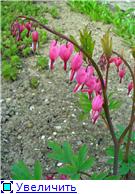 lily of the valley
lily of the valley
white acacia
badan
tulips
japonica
lilac
viper bow
peonies
primrose
hyacinth
center (diclitra, hearts) ( Dicentra Bernh.)
Dicentra gorgeous, or broken heart (Dicentra spectabilis (L.) Lem.), In the photo on the right
June
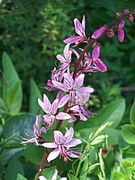 peonies
peonies
lilac
roses
turkish carnation
dittany* (Dictamnus albus L.), in the photo on the right
larkspur
lilies
day-lily
jasmine
daisies
irises
dahlias
catchment (Orlik, aquilegia) ( Aquilegia L.)
sweet pea
yarrow
July
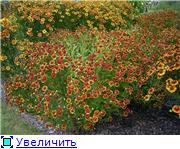 lilies
lilies
adonis
dahlias
larkspur
phlox
gelenium (Helenium L.), in the photo on the right
astilba
gypsophila
gladioli
levkoy
asters
August
 asters
asters
roses
phlox
gladioli
dahlias
goldenrod
astilba (Astilbe Buch.-Ham. ex D.Don), see photo
levkoy
rudbeckia
gelenium
larkspur
September
dahlias
phlox (Phlox L.) in the photo on the right
gladioli
gelenium
asters
October
 asters
asters
gladioli
dahlias
host (funky) (Hosta Tratt.), In the photo on the right
__________
* Poisonous plants. Care should be taken and security measures in contact with them. If you have small children, then we do not recommend growing these plants in your garden.
When choosing flowers for the garden should be preferred perennialsthat give a lot of flowers and greenery, grow in one place for many years. For example, phlox can grow in one place without a transplant and special care up to 5 years, peonies - up to 10 years.
Perennials are more unpretentious, have a more powerful root system, suffer from drought less, reproduce easily and quickly.
Annuals Plants are preferably planted in a new garden, as their main advantage over perennial ones is that they bloom in the very first season.

